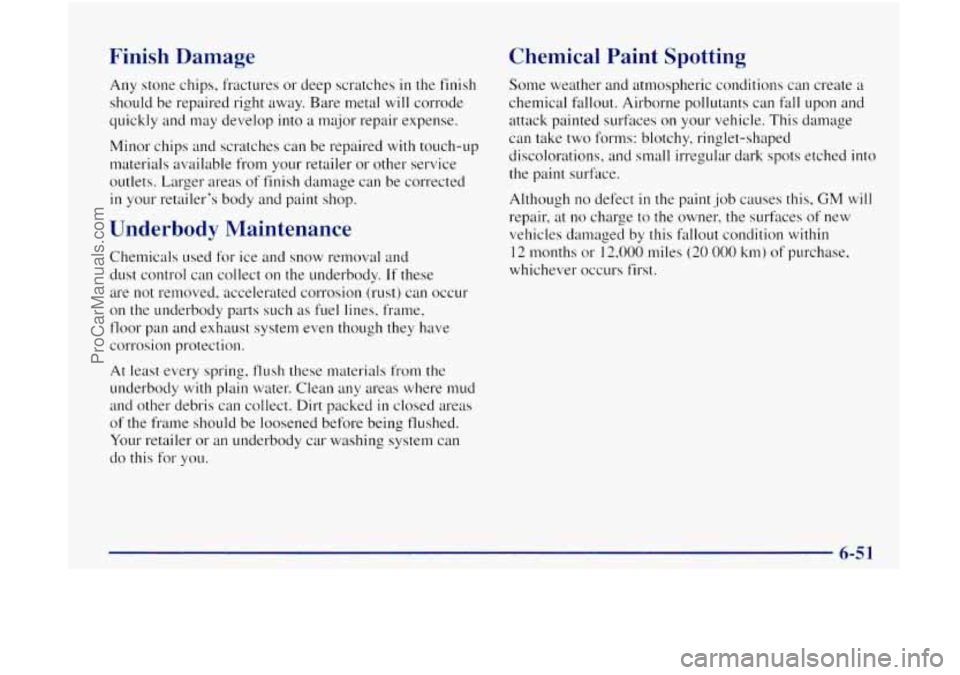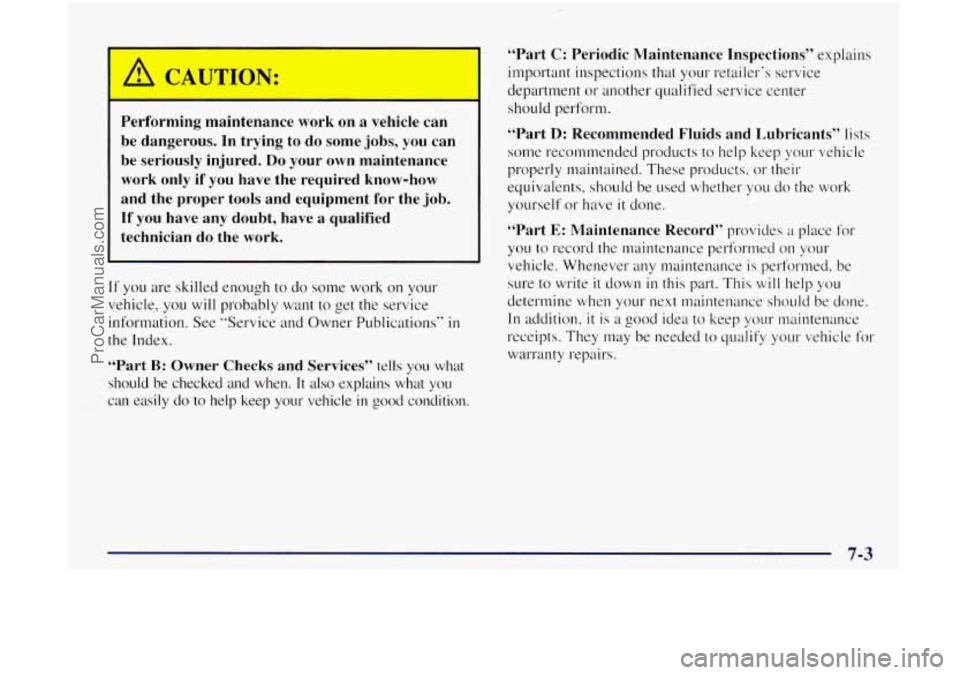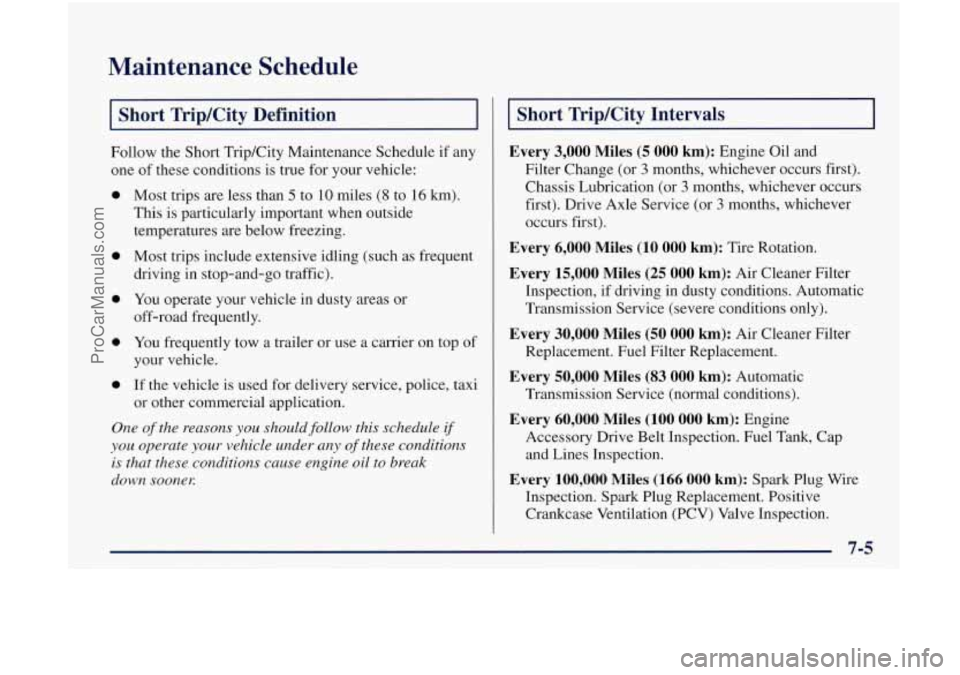service OLDSMOBILE BRAVADA 1998 Service Manual
[x] Cancel search | Manufacturer: OLDSMOBILE, Model Year: 1998, Model line: BRAVADA, Model: OLDSMOBILE BRAVADA 1998Pages: 380, PDF Size: 19.2 MB
Page 281 of 380

Tire Inspection and Rotation
Tires should be rotated every 6,000 to 8,000 miles
(10 000 to I3 000 km). Any time you notice unusual
wear, rotate your tires as
soon as possible and check
wheel alignment. Also check for damaged tires or
wheels. See “When
It’s Time for New Tires” and
“Wheel Replacement” later
in this section for
more information.
The purpose of regular rotation is to achieve more
lrniform wear for all tires on the vehicle. The first
rotation is the most important. See ”Scheduled
Maintenance Services”
in the Index for scheduled
rotation intervals. When rotating your
tires, always use the correct rotation
pattern shown here.
If your vehicle has a compact spare tire, don’t include it
in your tire rotation.
After the tires have been rotated, adjust the front and
rear inflation pressures as shown
on the
CertificatiodTire label. Make certain that all wheel nuts
are properly tightened. See “Wheel
Nut Torque’‘ in
the Index.
Rust or dirt on a wheel, or on the parts to which
it is fastened, can make wheel nuts become loose
after a time. The wheel could come off and cause
an accident. When you change
a wheel, remove
any rust or dirt from places where the wheel
attaches to the vehicle. In an emergency, you can
use a cloth or a paper towel
to do this; but be
sure to use a scraper or wire brush later, if you
need to, to get all the rust or dirt off. (See
“Changing a Flat Tire” in the Index.)
ProCarManuals.com
Page 282 of 380

When It’s Time for New Tires
I One way to tell when it’s
time .for new tires is to
check the treadwear
indicators, which
will
appear when your tires have
only 1/16 inch (1.6 mm) or
less of tread remaining.
You need a new tire
if any of-. the following statements
are true:
You can see the indicators at three or more places
around the tire.
a You can see cord or fabric showing through the
tire’s rubber.
0 The tire has a bump, bulge or split.
The tire has a puncture, cut or other damage that
can’t be repaired well because
of the size or location
of the damage.
Buying New Tires
To find out what kind and size of tires you need, look at
the Certification/Tire label.
The tires installed on your vehicle when
it was new had
a Tire Performance Criteria Specification (TPC Spec)
number on each tire’s sidewall. When you get new tires,
get ones
with that same ?’PC Spec number. That way
your vehicle
will continue to have tires that are designed
to give proper endurance, handling, speed rating,
traction, ride and other things durinz normal service on
your vehicle.
If your tires have an all-season tread
design. the
TPC number will be followed by an “MS”
(for mud and snow).
If you ever replace yo~~r tires with those not having a
TPC Spec number, make sure they are the same size,
The tread or sidewall is cracked, cut or snagged deep load
range, speed rating and construction type (bias,
bias-belted or radial) as your original tires.
enough to show cord or fabric.
ProCarManuals.com
Page 284 of 380

Treadwear
The treadwear grade is a comparative rating based on
the wear rate of the tire when tested under controlled
conditions on a specified government test course. For
example,
a tire graded 150 would wear one and a half
(1 1/2) times as well on the government course as a tire
graded
100. The relative performance of tires depends
upon the actual conditions of their use, however, and
may depart significantly from the norm due
to variations
in driving habits, service practices and differences
in
road characteristics and climate.
Traction -- A, B, C
The traction grades, from highest to lowest, are
A, B, and C, and they represent the tire’s ability to stop
on wet pavement as measured under controlled
conditions on specified government test surfaces of
asphalt and concrete.
A tire marked C may have poor
traction performance.
Warning: The traction grade assigned to this tire is based
on braking (straight ahead) traction tests and does not
include cornering (turning) traction.
Temperature -- A, B, C
The temperature grades are A (the highest), B, and C,
representing the tire’s resistance to the generation of
heat and its ability to dissipate heat when tested under
controlled conditions
on a specified indoor laboratory
test wheel. Sustained high temperature can cause
the
material of the tire to degenerate and reduce tire life, and
excessive temperature
can lead to sudden tire failure.
The grade
C corresponds to a level of performance
which all passenger car tires must meet under the
Federal Motor Vehicle Safety Standard
No. 109. Grades
B and A represent higher levels of performance on the
laboratory test wheel than the minimum required by law.
Warning: The temperature grade
for this tire is
established for a tire that is properly inflated and not
overloaded. Excessive speed, underinflation, or
excessive loading, either separately
or in combination,
can cause heat buildup and possible tire failure.
6-42
ProCarManuals.com
Page 293 of 380

Fi nish Damage
Any stone chips, fractures or deep scratches in the finish
should be repaired right away. Bare metal
will corrode
quickly and may develop into a major repair expense.
Minor chips and scratches can be repaired
with touch-up
materials available from your retailer or other service
outlets. Larger areas of
finish damage can be col-rect.ed
in your retailer’s body and paint shop.
Underbody Maintenance
Chemicals used for ice and snow removal and
dust control can collect on the underbody.
If these
are not removed, accelerated corrosion (rust) can occur
on the underbody parts such as fuel lines, frame,
floor pan and exhaust system even though they have
corrosion protection.
At least every spring, flush these materials
from the
underbody with plain water. Clean any areas where mud
and other debris can collect. Dirt packed
in closed areas
of the frame should be loosened before being flushed.
Your retailer or an underbody car washing system can
do this for you.
Chemical Paint Spotting
Some weather and atmospheric conditions can create a
chemical fallout. Airborne pollutants can
fill upon and
attack painted surfaces on your vehicle.
This damage
can take two forms: blotchy, ringlet-shaped
discolorations, and small irregular dark spots etched into
the paint surface.
Although no defect
in the paint job causes this, GM will
repair, at no charge to the owner, the surfaces of new
vehicles damaged by this fallout condition within
12 months or 12,000 miles (20 000 km) of purchase.
whichever occurs first.
ProCarManuals.com
Page 295 of 380

Vehicle Identification Number (VIN)
ENGINE A98 f ASSEMBLY
CODE A MODEL YEAR
PLANT
-
This is the legal identifier for your vehicle. It appears on
a plate in the front corner of the instrument panel, on the
driver's side. You can see
it if YOLI look through the
windshield from outside your vehicle. The
VIN also
appears on the Vehicle Certification and Service Parts
labels and the certificates
of title and registration.
Engine Identification
The 8th character in your VIN is the engine code. This
code
will help you identify your engine, specifications
and replacement parts.
Service Parts Identification Label
You'll find this label on the inside of the glove box. It's
very helpful if you ever need to order parts. On this
label is:
YOLI~ VIN,
the model designation.
a list of all production options and
special equipment.
Be sure that this label is not removecl from the vehicle.
ProCarManuals.com
Page 305 of 380

a Section 7 Maintenance Schedule
This section covers the maintenance required for your vehicle. Your vehicle needs these services tQ retain its safety.
dependability and emission control performance.
7-2
7-4
7-5
7-5
7-6
7-6
Introduction
Part
A: Schecluled Maintenance Service
Short Trip/City Definition
Short Trip/City Intervals
Long Trip/Highway Definition
Long Trip/Highway Intervals 7-7 7-27
7-39
7-43
7-4s
7-47
Short Trip/City Maintenance Schedule
Long Trip/Highway Maintenance Schedule
Part
B: Owner Checks and Services
Part C: Periodic Maintenance Inspections
Part
D: Recommended Fluids and Lubricants
Part
E: Maintenance Record
-
ProCarManuals.com
Page 306 of 380

Introduction
IMPORTANT:
KEEP ENGINE OIL
AT THE PROPER
.VEL AND CHANGE
RECOMMENDED
11
.I
Your Vehicle and the EnvironmcC
Proper vehicle maintenance not only helps to keep your
vehicle
in good working condition, but also helps the
environment.
All recommended maintenance procedures
are important. Improper vehicle maintenance can even
affect the quality of the air we breathe. Improper fluid
levels or the wrong tire inflation can increase
the level
of emissions from your vehicle. To help protect our
environment. and to keep your vehicle
in good
condition, please maintain your vehicle properly.
How This Section is Organized
The remainder of this section is divided into five parts:
“Part A: Scheduled Maintenance Services” shows
what to have done and how often. Some
of these
services can be complex,
so unless you are technically
qualified
and have the necessary equipment, you should
let your retailer’s service department or another
qualified service center do these
jobs.
7-2
ProCarManuals.com
Page 307 of 380

Performing maintenance work on a vehicle can
be dangerous. In trying to do some jobs,
you can
be seriously injured.
Do your own maintenance
work only if
you have the required know-how
and the proper tools and equipment for the job.
If you have any doubt, have a qualified
technician do the work.
If you are skilled enough to do some work on your
vehicle, you
will probably want to get the service
information. See “Service and Owner Publications“
in
the Index.
“Part B: Owner Checks and Services” tells you what
should be checked and when.
It also explains what you
can easily
do to help keep your vehicle in good condition.
“Part C: Periodic Maintenance Inspections” explains
important inspections that
your retailer’s service
department or another qualified service center
should perform.
“Part D: Recommended Fluids and Lubricants” lists
some recommended products to help keep your vehicle
properly maintained. These products,
or their
equivalents, should be used whether you do the work
yourself or have
it clone.
“Part E: Maintenance Record” provides a place lor
you to record the maintenance performed
on your
vehicle. Whenever any maintenance is perfornled, be
sure to write
it down in this part. This will help you
determine when your next maintenance
should be clone.
In acldition, it is a good idea to keep your maintenance
receipts. They may be needed to qualify your vehicle
for
warranty repairs.
7-3
ProCarManuals.com
Page 308 of 380

Part A: Scheduled Maintenance
Services
Using Your Maintenance Schedule
We at General Motors want to help you keep your vehicle
in good working condition. But we don‘t know exactly
how you’ll drive
it. You may drive very short distances
only a few times
a week. Or you may drive long distances
all
the time in very hot, dusty weather. You may use your
vehicle
in making deliveries. Or you may drive it to work,
to do en-ands or
in many other ways.
Because of
all the different ways people use their
vehicles, maintenance needs vary. You may even need
more frequent checks and replacements than
you’ll find
in the schedules in this section. So please read this
section and note how you drive.
If you have any
questions on how to keep your vehicle
in good
condition, see your
GM retailer.
This part tells you the maintenance services you should
have done and
when you should schedule them. If you
go to your retailer for your service needs, you’ll know
that GM-trained and supported service people
will
perform the work using genuine GM parts. The proper fluids and lubricants to use are listed
in
Part D. Make sure whoever services your vehicle uses
these.
All parts should be replaced and all necessary
repairs done before you
or anyone else drives the vehicle.
These schedules are for vehicles
that:
0 carry passengers and cargo within recommended
limits. You
will find these limits on your vehicle’s
Certification/Tire label. See “Loading Your Vehicle”
in the Index.
0 are driven on reasonable road surfaces within legal
driving limits.
0 use the recommended fuel. See ”Fuel” in the Index.
Selecting the Right Schedule
First you’ll need to decide which of the two schedules is
right for your vehicle. Here’s how to decide which
schedule to follow:
ProCarManuals.com
Page 309 of 380

Maintenance Schedule
I Short Trip/City Definition
Follow the Short Trip/City Maintenance Schedule if any
one of these conditions is true for your vehicle:
0
0
0
0
0
Most trips are less than 5 to 10 miles (8 to 16 km).
This is particularly important when outside
temperatures are below freezing.
Most trips include extensive idling (such as frequent
driving in stop-and-go traffic).
You operate your vehicle in dusty areas or
off-road frequently.
You frequently tow a trailer or use a carrier on top of
your vehicle.
If
the vehicle is used for delivery service, police, taxi
or other commercial application.
One of the reasons you should follow this schedule if
you operate your vehicle under any of these conditions
is that these conditions cause engine oil to break
down sooney:
Short Trip/City Intervals
Every 3,000 Miles (5 000 km): Engine Oil and
Filter Change (or
3 months, whichever occurs first).
Chassis Lubrication (or
3 months, whichever occurs
first). Drive Axle Service (or
3 months, whichever
occurs first).
Every 6,000 Miles (10 000 km): Tire Rotation.
Every 15,000 Miles (25 000 km): Air Cleaner Filter
Inspection, if driving in dusty conditions. Automatic
Transmission Service (severe conditions only).
Every 30,000 Miles (50 000 km): Air Cleaner Filter
Replacement. Fuel Filter Replacement.
Every 50,000 Miles (83 000 km): Automatic
Transmission Service (normal conditions).
Every 60,000 Miles (100 000 km): Engine
Accessory Drive Belt Inspection. Fuel Tank, Cap
and Lines Inspection.
Every 100,000 Miles (166 000 km): Spark Plug Wire
Inspection. Spark Plug Replacement. Positive
Crankcase Ventilation (PCV) Valve Inspection.
7-5
ProCarManuals.com